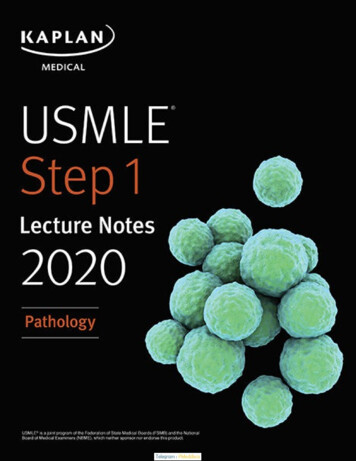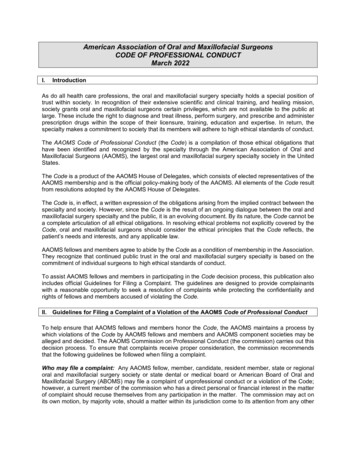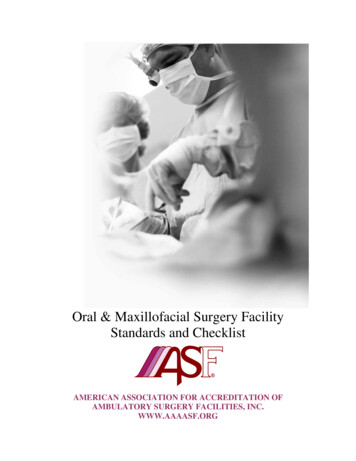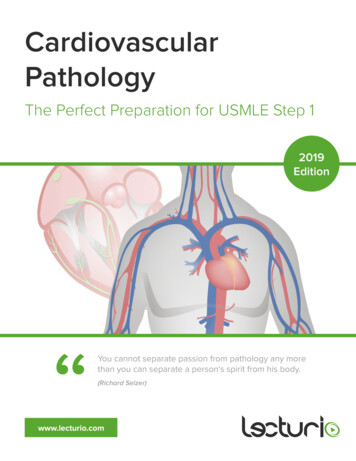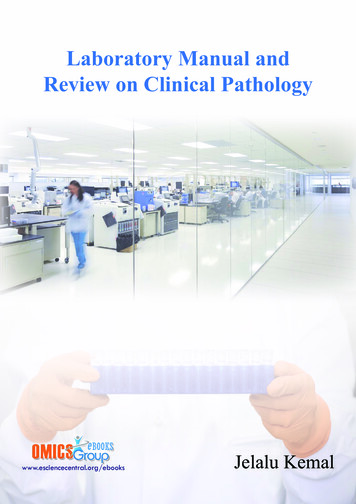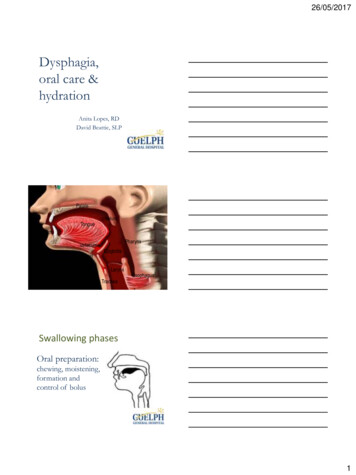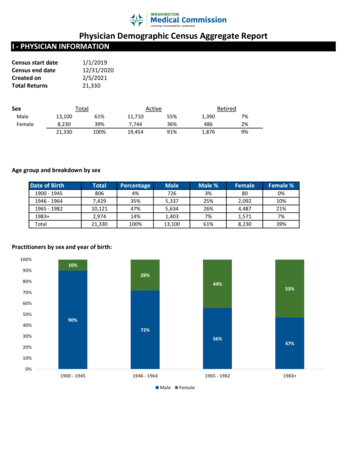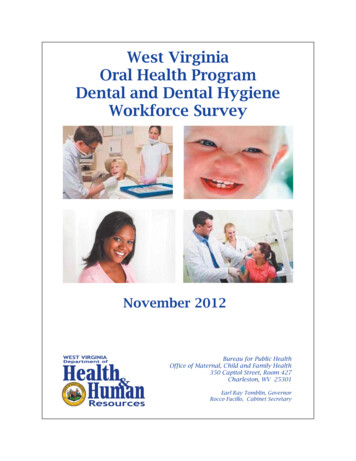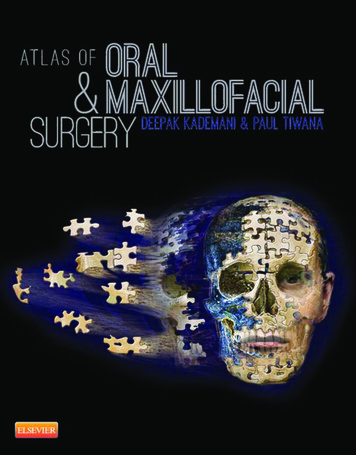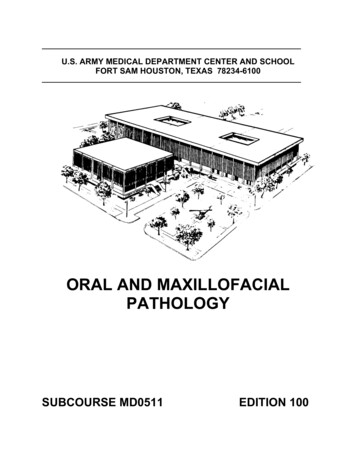
Transcription
U.S. ARMY MEDICAL DEPARTMENT CENTER AND SCHOOLFORT SAM HOUSTON, TEXAS 78234-6100ORAL AND MAXILLOFACIALPATHOLOGYSUBCOURSE MD0511EDITION 100
DEVELOPMENTThis subcourse is approved for resident and correspondence course instruction. Itreflects the current thought of the Academy of Health Sciences and conforms to printedDepartment of the Army doctrine as closely as currently possible. Development andprogress render such doctrine continuously subject to change.ADMINISTRATIONFor comments or questions regarding enrollment, student records, or shipments,contact the Nonresident Instruction Section at DSN 471-5877, commercial (210) 2215877, toll-free 1-800-344-2380; fax: 210-221-4012 or DSN 471-4012, e-mailaccp@amedd.army.mil, or write to:COMMANDERAMEDDC&SATTN MCCS HSN2105 11TH STREET SUITE 4192FORT SAM HOUSTON TX 78234-5064Approved students whose enrollments remain in good standing may apply to theNonresident Instruction Section for subsequent courses by telephone, letter, or e-mail.Be sure your social security number is on all correspondence sent to the Academy ofHealth Sciences.CLARIFICATION OF TRAINING LITERATURE TERMINOLOGYWhen used in this publication, words such as "he," "him," "his," and "men" are intendedto include both the masculine and feminine genders, unless specifically stated otherwiseor when obvious in context.USE OF PROPRIETARY NAMESThe initial letters of the names of some products are capitalized in this subcourse. Suchnames are proprietary names, that is, brandnames or trademarks. Proprietary nameshave been used in this subcourse only to make it a more effective learning aid. The useof any name, proprietary or otherwise, should not be interpreted as an endorsement,deprecation, or criticism of a product. Nor should such use be considered to interpretthe validity of proprietary rights in a name, whether it is registered or not.
TABLE OF CONTENTSLessonParagraphsINTRODUCTION1DISEASES OF THE HARD TISSUESection I.Section II.Section III.Section IV.Section V.Section VI.Section VII.General Information on Oral PathologyErosion, Abrasion, and ResorptionDental CariesDiseases of the Dental PulpDiseases of the Periapical TissuePeriodontal DiseasesAbnormalities of Oral -1-331-34--1-401-41--1-59Exercises2DISEASES OF THE SOFT TISSUESection I.Oral Tumors (Neoplasms) and LaboratoryStudiesSection II. Abnormalities of the TongueSection III. Developmental Anomalies of the TeethSection IV. Oral Manifestations of Systemic DiseasesSection V. Transmittable -2-37Exercises3FRACTURES AND DISLOCATION OF THE JAWExercisesMD0511i3-1--3-6
CORRESPONDENCE COURSE OF THEU.S. ARMY MEDICAL DEPARTMENT CENTER AND SCHOOLSUBCOURSE MD0511ORAL AND MAXILLOFACIAL PATHOLOGYINTRODUCTIONMan's survival is constantly threatened--by bacteria, by physical or chemicalinjury, and a host of other agents. Although modern science and medicine have donemuch to cope with these harmful influences, our greatest protection is still afforded bythe ability of our bodies to withstand these repeated attacks. If the combination ofscience and natural resistance is unable to ward off the damaging influences, diseasewill result. The study of disease and of alterations in function caused by disease iscalled pathology. Frequently considered in this field are such topics as the cause of thedisease, the effect of the disease on the body, and the body's reaction to the diseaseprocess.This subcourse is designed to acquaint you with the fundamental concepts oforal and maxillofacial pathology. It also seeks to familiarize you with the technicalnomenclature used in pathology, which is essential to understanding dental procedures.It also stresses the cause and effect of oral infection.Subcourse Components:This subcourse consists of three lessons. The lessons are as follows:Lesson 1, Diseases of the Hard Tissue.Lesson 2, Diseases of the Soft Tissue.Lesson 3, Fractures and Dislocation of the JawCredit Awarded:To receive credit hours, you must be officially enrolled and complete anexamination furnished by the Nonresident Instruction Branch at Fort Sam Houston,Texas. Upon successful completion of the examination for this subcourse, you will beawarded 7 credit hours.You can enroll by going to the web site http://atrrs.army.mil and enrolling under"Self Development" (School Code 555).A listing of correspondence courses and subcourses available through theNonresident Instruction Section is found in Chapter 4 of DA Pamphlet 350-59, ArmyCorrespondence Course Program Catalog. The DA PAM is available at the followingwebsite: 511ii
LESSON ASSIGNMENTLESSON 1Diseases of the Hard Tissue.LESSON ASSIGNMENTParagraphs 1-1 through 1-59.LESSON OBJECTIVESAfter completing this lesson, you should be able to:SUGGESTIONMD05111-1.Identify terminology related to tissueinflammation of the oral cavity.1-2.Identify the results of oral tissue inflammation.1-3.Identify the results of dental caries.1-4.Identify major diseases of the dental pulp.1-5.Identify major diseases of the periapical tissue.1-6.Identify tooth structure problems caused bychemical, mechanical, or other means.1-7.Identify major periodontal diseases.1-8.Identify major abnormalities of theoral mucosa.After studying the assignment, complete the exercisesof this lesson. These exercises will help you to achievethe lesson objectives.1-1
LESSON 1DISEASES OF THE HARD TISSUESection I. GENERAL INFORMATION ON ORAL PATHOLOGY1-1.GENERALa. Pathology is the study of disease, especially of the structural and functionalchanges in tissues and organs that cause or are caused by disease. Oral pathology isthat branch of pathology concerned with diseases of the oral cavity. Microbiology is thestudy of microorganisms, including bacteria, fungi, and viruses. Disease is a particulardestructive process in an organism, usually with a specific cause and characteristicsigns and symptoms. A sign is objective evidence of disease that is detectable by thehealth care provider; for example, redness or bleeding. A symptom is subjectiveevidence of disease--in other words, what a patient tells the health care provider.Examples of symptoms would be pain and weakness. The word asymptomatic refers toa disease exhibiting no symptoms.b. Terminology of a descriptive nature is used to define aspects of a pathologicalprocess. Local (localized) means that the disease is restricted to a part or small area ofthe body. Generalized means the disease affects all parts of the body or covers a largearea (many organ systems). Incipient refers to a disease or disorder that is justbeginning. Severe refers to an intense distress of prolonged duration caused by thedisease process. Acute relates to a sudden onset of symptoms, generally of shortduration. Chronic refers to a prolonged disease process, with symptoms generally of aconstant nature.NOTE: As you study this subcourse, you may wish to refer to Subcourse MD0501,Dental Anatomy and Physiology.1-2.INFLAMMATION OF TISSUESWhen a tissue is injured or irritated by mechanical, chemical, thermal, or bacterialagents, it becomes inflamed. Inflammation is the reaction of a tissue to an injuriousagent. The body does not always overcome the attack and so disease persists. Forexample, the irritation produced by dental caries may result in inflammation of the pulp.This pulpal inflammation is called pulpitis. (The suffix "itis" indicates that inflammationexists.) In every case, the inflammatory condition results from some form of irritationand, to restore normal function to the tissues, the cause must be eliminated. Thefunction of inflammation is to activate all the defenses of the body and to bring them tothe site of the injury with the purpose of overwhelming the source of the injury orirritation.MD05111-2
1-3.STAGES OF INFLAMMATIONInflammation is a body defense mechanism that occurs regardless of the sourceof injury. The inflammatory response is progressive, in stages; however, it should berealized that various stages may exist within an injured area at the same time. Themajor stages in the inflammatory process are: vascular change, exudation, and repair.The initial inflammatory response is vascular tissue injury, resulting in the followingsequence of events.a. Hyperemia. The presence of an abnormally large blood supply in which theblood vessels are dilated and the flow of blood is slower.b. Permeability. Increased permeability in the smaller blood vessels, allowingthe body to position blood elements in the area in order to heal the injured tissue orcombat any introduced foreign agents.c. Exudation. The movement of fluid and blood cellular elements (exudates)into the injured tissue(s).d. Edema. Accumulation of fluids within the tissue(s) that then slows orstagnates blood flow. This acts to localize the inflammatory process.1-4.MAJOR SIGNS AND SYMPTOMS OF INFLAMMATIONThe four major signs and symptoms of inflammation are swelling, pain, heat, andredness. Sometimes a fifth sign is disturbance of function. Swelling is the visual sign ofthe accumulation of inflammatory substances (exudates) in the tissues and theincreased amount of blood in the area. The pressure of the exudates (and perhaps theaction of toxins, enzymes, and acids released from injured cells or liberated bydefensive cellular elements) on the nerve endings causes pain. The redness and heatthat accompany inflammation are due to the increased amount of blood in the area.Inflammatory involvement of the tissue may result in disturbance of function.1-5.BENEFICIAL EFFECTS OF INFLAMMATIONThe beneficial effects of inflammation are essentially fourfold. First, theincreased fluid dilutes the irritants present in the area (that is, bacteria and their poisonousproducts). Second, the blood cells engulf and often digest bacteria, dead cells, or otherdebris that might cause or continue the inflammation. Third, antibodies, which are alsopresent in the edema fluid, neutralize toxic substances. Fourth, clotting of the edemafluid walls off the area and prevents the irritant and the inflammation or the inflammatoryprocess from spreading beyond the affected site.MD05111-3
1-6.SUPPURATIONSuppuration is the formation of pus. It often accompanies inflammation andretards the healing process. Pus is composed of leukocytes, broken-down cells, serum,bacteria (dead or alive), and inflammatory debris.1-7.ABSCESSAn abscess is a circumscribed area of pus surrounded by a restraining wall oftissue. A narrow tube or channel that often develops to afford drainage of the abscessis called a sinus track. A periapical abscess is a collection of pus at the apex of thetooth. It is caused by the spread of infection through the apical foramen of the tooth tothe periapical tissues. A periodontal abscess is a collection of pus along the sides ofthe tooth but usually not involving the apical area. It may be caused by a foreign objectforced into the periodontal tissues. Abscesses are often clinically manifested byswelling.1-8.ULCERAn ulcer is an open sore other than a wound. The base of an ulcer is composedof granulation tissue (wound repair tissue) resulting from the body's attempt at healingand repair.1-9.CELLULITISCellulitis occurs when inflammation is not controlled and contained within alocalized area and spreads through the substance of the tissue or organ. In cellulitis,swelling usually develops rapidly in conjunction with a high fever. The skin usuallybecomes very red and the area is characterized by severe throbbing pain as theinflammation localizes. The condition is often associated with periapical, periodontal, orpericoronal infections.1-10. REPAIR OF TISSUESa. General. The capacity of the human body to restore damaged tissues tohealth varies with the particular type of tissue or cells involved. Worn-out cells arereplaced and tissues rebuilt as a normal physiological process to bring about the growthand repair of the body as a whole. Once tissue injury has been controlled by theinflammatory process, wound repair can begin. Cells in the area of the injury proliferate,organizing to return the tissue to its original form with resumption of previous function.The process of healing is fundamentally the same in all damaged tissues. It consists oftwo parts. First is the removal of inflammatory material and necrotic debris. Thesecond part, as much as possible, is the replacement or reconstruction of the originaltissue.MD05111-4
b. Granulation. The process of healing involves the invasion and replacementof dying and dead tissue by immature mesenchyma called granulation tissue.Granulation tissue consists mostly of fibroblasts and capillaries. As wound repairprogresses, the fibrous and vascular cell components gradually convert into a maturetissue. Then, old epithelial cells at the wound edge proliferate to cover the new fibroustissue surface. If the wound edges are not brought together or are exposed to irritantsor infections, granulation tissue forms on the opposing surfaces and fills the space.c. First Intention. This is the healing process observed when the woundsurfaces are close together, such as in a small cut or in a closely sutured wound. Thefirst step in repair is the formation of a clot. This clot is slowly replaced by granulationtissue and a covering of epithelium. When the edges of a clean aseptic wound areclosely approximated, rapidly growing (proliferative) connective tissue cells join thewalls of the wound and proliferative epithelial cells close over the surface. In firstintention, the wound heals without scarring.d. Second Intention. This is the healing process observed when the opposingedges of the wound are not together, such as in a large ulcer. Granulation tissue fills inthe wound from the base and eventually is covered with epithelium. In many instances,repair results in less than completely normal regeneration, causing altered tissuestructure that forms a fibrous scar. In second intention, healing is often characterizedby the formation of a scar.Section II. EROSION, ABRASION, AND RESORPTION1-11. GENERALThere are three conditions (besides dental caries) in which there is loss of toothsubstance. They are erosion, abrasion and attrition, and resorption.1-12. EROSIONErosion is the chemical wearing away of the tooth structure by a chemicalprocess that does not involve bacterial function. A common cause of erosion is chronicvomiting which results in enamel destruction through the action on teeth by stomachacids. Excess use of acidic carbonated beverages or acid citrus fruits may also becausative factors. Erosion is usually found on the external surface of the tooth onenamel structure adjacent to the cemento-enamel junction. It appears as variousshapes cut into the surface at the neck of the tooth. The enamel and dentin are usuallyhard and shiny. In certain cases, the crowns may be severed from the roots.Considerable variation in appearance is normal between cases, but generally severalteeth are involved, usually on the outer (labial) aspect of the crown.MD05111-5
1-13. ABRASION AND ATTRITIONAbrasion is considered to be an abnormal or excessive wearing away of toothsubstance by a mechanical process. It can be seen clinically. In abrasion, one or moreteeth may show the effects of wear. The wearing of the tooth substance may be causedby biting some foreign substance such as a pipe stem or a bobby pin, by faulty toothbrushing techniques, or by nervous biting habits. Attrition is the wearing away of toothstructure due to contact with an opposing tooth. It involves all the teeth with the cuspsand contact points of all the teeth showing uniform wear. Abrasion and attrition differ inthat attrition is considered a normal, gradual loss of tooth substance from the chewing offood and it involves all of the teeth, which will show uniform wear. If the loss of toothsubstance is excessive, it is called abrasion. In both cases, the dentinal tubules maybecome calcified and secondary or irregular dentin may be deposited in the pulpimmediately below them. Secondary cementum may be laid down about the roots.1-14. RESORPTIONa. General. In resorption, there is the dissolving (removal) of body tissues bybody fluids or cellular activity. Osteoclasts (cells that destroy bone) and cementoclasts(cells that destroy cementum) are the cells active in the resorption of bone andcementum. The condition is evident most often in the alveolar process and in the rootsof teeth. Certain types of resorption may be considered normal. Other types may bethe result of abnormal conditions. Healthy bone is constantly being remodeled.Resorption and deposition of bone is a normal physiological process and the principlethat allows orthodontic movement of teeth. Stimulation of resorptive cellular activitythrough excessive mechanical or occlusal forces or through the normal shedding of theprimary dentition is also within normal resorptive function. The effects of resorption canoften be seen on a radiograph. Pathological resorption may be initiated throughinflammatory stimulation or as the result of pressure exerted by developing neoplasmsor cysts.b. Normal Resorption. The roots of deciduous teeth are resorbed just beforethe eruption of the permanent teeth. There is also normal resorption of bone inedentulous areas where permanent teeth have been extracted. Healthy bone isconstantly being remodeled. Resorption and deposition of bone is the basis for thetreatment applied by the orthodontist who moves malposed teeth slowly into properposition. Resorption is also important in the repair of a fracture and the healing of atooth socket.c. Abnormal Resorption. There are other types of resorption that may not beconsidered normal. Resorption of the roots of permanent teeth may be the result ofmany factors involving disease and trauma. For example, systemic (endocrine)disturbances and some neoplasms are characterized by bone and root resorption.Impacted teeth may impose upon the roots of other teeth to cause areas of resorption.MD05111-6
d. External and Internal Resorption. Resorption of a tooth may developexternally or internally. Internal resorption is usually caused by inflammatory pulpalstimulation. External resorption may be caused by inflammatory stimulation ofresorptive cells or through stimulation of resorptive cells associated with the pressureexerted by developing pathology or impacted teeth. This can cause resorption of toothstructure and surrounding alveolar bone. The cell responsible for the active resorptiveprocess in bone is an osteoclast just as the cementoclast is for cementum. Theosteoclast is developed from connective tissue cellular components in the pulp or areaadjacent to an inflammatory stimulus outside the tooth.Section III. DENTAL CARIES1-15. GENERALDental caries is a term for the process commonly referred to as decay of theteeth. Thus, a decayed tooth is properly termed a carious tooth. Dental caries or dentaldecay is a specific disease that causes dissolution and disintegration of the hardstructures of the tooth, that is, enamel, cementum and dentin. (The word caries ordecay refers to the disease; the word cavity refers to the lesion or hole in the tooth.)Dental caries is the most widespread disease affecting the human race. The incidenceof caries is greatest during childhood and young adulthood. It attacks deciduous teeththe same as it attacks permanent teeth. Dental caries is progressively destructive. Itusually begins in a minute area on the enamel or cementum and, if untreated,progresses to the dentin. The next step is penetration to involve the dental pulp.Infection and death of the pulp may follow, with possible extension of the infection intothe tissues surrounding the apical portion of the root and the formation of an abscess.The control of dental caries is a very important problem that is receiving much attentionin the fields of research and prevention.1-16. CAUSESIn general, dental caries occurs because of improper or poor oral hygiene. Thedestruction of dental tissue by caries, however, is governed somewhat by thesusceptibility of the teeth. Little is known about susceptibility or resistance to caries, butthe degree of susceptibility may be influenced by certain factors, including diet and oralhygiene and some systemic diseases. Study of the direct cause of dental caries is verycomplex. Only two theories of its cause are considered here. According to theacidogenic (producing acid) concept, bacteria and their products accumulate inmucinous plaques, which are often invisible and adhere tightly to the teeth. Thebacteria in the plaques metabolize (feed upon) carbohydrates in the diet and convertthem to organic acids. These acids dissolve the enamel and allow deeper bacterialMD05111-7
penetration into the tooth. The lesion is progressive. According to the proteolytic(effecting the digestion of proteins) concept, proteolytic bacteria attack the organicmaterial in the enamel rods (which is mostly protein) along certain tracts called lamellae.Dissolution of the organic material in these lamella tracts eventually allows bacterialpenetration to the underlying dentin. According to both concepts, dental caries is theresult of microbial activity on the teeth. The process of dental caries may be acombination of both concepts, with the acidogenic concept accounting for dissolution ofmineral content and the proteolytic concept accounting for destruction of organiccontent of the tooth.1-17. CARIES IN ENAMEL (Figure 1-1)The organisms that produce acid are contained in mucinous plaques that adhereto the surface of the enamel. Common sites of plaque adherence are pits, fissures,interproximal areas, and along the free margin of the gingivae, particularly on the facialsurface of the tooth. The enamel rods of a tooth are cemented together by a substancethat dissolves more readily than the rods themselves, and thus, according to theacidogenic concept, the first effect in enamel caries is probably the dissolution of thiscementing substance. The first visible evidence of caries is a slightly whitened area onthe surface of the tooth (decalcification). This area is very easily overlooked,particularly when the teeth are wet. Drying of the tooth surface makes these areas farmore visible. From the small areas on the surface of the tooth, caries continues itsprogressive destruction. As the acid dissolves the cementing substances, the enamelrods are left without support and break away. Since enamel contains a minimal amountof organic material, the primary acid effect on the enamel cementing substance resultsin loss of enamel structural support. Without support, the enamel rods break away,allowing progressive formation of a cavity within the enamel, until ultimately dentin isalso involved. In summary, caries first penetrates the enamel and dentinoenameljunction. Then it spreads laterally and deeper within the dentin toward the pulp. Thus,what may appear to the patient as a small surface cavity may in fact be a very extensiveinvolvement of the tooth structure.MD05111-8
Figure 1-1. Stages in the progress of dental caries.NOTE: Dental decay generally starts in areas that are not easily or normally cleaned.Figure B shows primary areas of enamel decay, between the teeth and on thechewing surface. Spread of decay in dentin is shown in Figure C; note lateraladvancement as well as progression of decay toward the pulp. With pulpalinvolvement, degenerative changes result in pathology within the pulp chamber(Figure D), resulting in eventual periapical granuloma or cyst development(Figure E).MD05111-9
1-18. CARIES IN DENTINFrom the small area on the surface of the tooth, caries continues its progressivedestruction. As noted in the preceding paragraph, decay spreads easily within dentinafter penetrating the enamel. The disease spreads laterally along the dentinoenameljunction and directly toward the pulp.a. The Destructive Process. The destructive process of caries differs in dentinand enamel. In caries of enamel, the organisms cannot enter the substance of theenamel until the acid produced by the organisms has destroyed the enamel substance.This process is called demineralization. The reverse is true of the dentin, which is madeof many hollow tubules. These tubules offer a natural pathway for penetration bybacteria and because the dentin contains a large proportion of organic materials,progression is faster in dentin than in enamel. When the dentin has been reached,acid-forming and proteolytic organisms can enter the dentinal tubules and produce acidor break down the organic matrix within the tissue itself. Since dentinal tubules tend tobranch and communicate with each other at the dentinoenamel junction, the organismspenetrate the dentin laterally in all directions along this junction. Accompanying thislateral penetration is a penetration along the main tubules in the direction of the pulp.This lateral and direct involvement tends to form a cone-shaped area of decay. Theapex of the cone is pointed toward the pulp of the tooth and the base at thedentinoenamel junction.b. Limits to Dentin Destruction. Although dentin destruction in caries isnormally faster than enamel destruction, the rapidity of dentin destruction both in depthand breadth will be governed by its structure. Because of the extensive organic matrixof the dentin, enough substance is left after the dissolution of the inorganic salts toretain its physical form until further destruction has taken place by other processes.c. The Infected Layer and the Affected Layer. Caries in the dentin isdescribed as having an infected layer and an affected layer. In the infected dentin,many microorganisms are present and most of the dentinal tubules have beendestroyed through demineralization and decomposition (destructive process ofproteins). The infected layer is soft on the surface but gets tough, leathery, or rubberyunderneath. Below the infected layer is the affected layer of dentin. Fewmicroorganisms are found in this area and the dentinal tubules are intact. Normaldentin is found under the affected layer. The difference in these layers plays animportant role in the treatment of caries in the dentin.1-19. ARRESTED CARIESArrested caries is the stage where the progress of the decay process hasstopped. The softened dentin has been lost or worn away so that the discolored (eitheryellow, brown, or black), sound, hard dentin remains. The remaining dentin has apolished look.MD05111-10
1-20. PULPAL REACTION TO DENTAL CARIESa. The Reason for Pain. When dental decay reaches a depth in the dentin thatis near the pulp tissue inside of the tooth, the pulp tissue can become inflamed. Theinflammation causes the blood vessels to swell and release fluid into the extracellularspaces. This swelling is limited by the hard walls of the pulp chamber and root canalsand, as a result, severe pain may result because of the constriction. Pus canaccumulate within the diseased pulp tissue that further accelerates the pathologicprocess.b. The Process of Decay. The reaction of the pulp to dental caries varies. Thisreaction generally varies in accordance with the rate of advance of the carious process.Even before there is significant dentin involvement, the pulp tissue can become irritatedand the irritation causes minor inflammation. This, in turn, stimulates the odontoblaststo produce secondary dentin in an effort to protect the pulp. If the rate of advance ofcaries is slow and the resistance of the patient is high, this deposition of secondarydentin may prevent the carious process from reaching the pulp tissues for aconsiderable time. If it were not for this protective reaction of the odontoblasts, a farhigher percentage of carious lesions would reach the pulp chamber before detection,causing more injury to the pulp. If not treated or arrested, the carious process caneventually reach and involve the pulp tissue. As it nears the pulp, the irritation becomesmore severe and direct bacterial invasion occurs. If the resulting inflammation is severeor of prolonged duration, the pulp tissue may die (necrose) if left untreated.Section IV. DISEASES OF THE DENTAL PULP1-21. GENERALPulp is an extremely sensitive tissue that can only elicit pain. It can be subjectedto many irritations resulting from dental caries, exposure to excessive heat or cold, andmechanical, chemical, or electrical stimulation. In a healthy tooth, the enamel andperiodontal tissues act as mechanical and insulating coverings. If the enamel orcemental tissues covering the root are damaged or removed, the underlying dentin isexposed. The dentin then becomes sensitive to external irritants because of themovement of fluid in and out of the dentinal tubules. This fluid movement causesstimulation of the sensitive pain receptors inside the dentin pulp. Injuries such as dentalcaries, trauma, developmental defects and/or diseases, or dentistogenic (dentistcaused) injuries can have a negative effect on the pulp. Among the diseases that occurin the pulp are acute pulpitis, chronic pulpitis, pulp abscesses, hyperplastic pulpitis, anda number of degenerative changes (diseases) that take place. Acute and chronicpulpitis and pulp abscesses are commonly encountered in clinical dental practice.1-22. ACUTE PULPITISAcute inflammatory changes in the pulp are often caused by bacteria that havegained access to the exposed pulp. These changes may cause an initial inflammationMD05111-11
or a flare-up of a chronic inflammation. The active growth of the organisms in theenvironment of the pulp produces rapid destructive changes. These changes areaccompanied by symptoms which can be correspondingly severe. Clinically, severepulsating pain is caused by the rapid buildup of pressure within the tooth. Release ofpressure by opening into the pulp chamber brings almost immediate relief. If thecondition is severe enough, it may be accompani
oral and maxillofacial pathology. It also seeks to familiarize you with the technical nomenclature used in pathology, which is essential to understanding dental procedures. It also stresses the cause and effect of oral infection. Subcourse Components: This subcour
